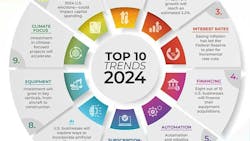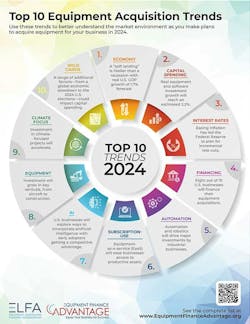The economy has proved more resilient than expected, according to the Equipment Leasing and Finance Association (ELFA), leading the group to forecast a “soft landing” as its No. 1 acquisition trend for 2024. The group represents the equipment and software finance sector.
“The resilient U.S. economy and opportunities for growth and greater efficiencies underlie the trends this year as equipment acquisition continues to drive supply chains across all U.S. manufacturing and service sectors,” said Leigh Lylte, ELFA president/CEO, in a statement. “Nearly eight in 10 of U.S. businesses use equipment leasing and financing to acquire the productive assets they need to operate and grow. We are pleased to provide the Top 10 Equipment Acquisition Trends to help businesses in their strategic equipment acquisition decision-making.”
Read also: 2024 Prices Remain a Concern for Fleets
ELFA distilled recent research and data, including the Equipment Leasing & Finance Foundation’s “2024 Equipment Leasing & Finance U.S. Economic Outlook,” industry participants’ expertise, and member input from ELFA meetings in compiling the trends.
Top 10 equipment acquisition trends
1. The U.S. economy will likely have a soft landing. Although a recession is still possible in the first half of 2024, the likelihood of a “soft landing” is increasing. The combination of cooling inflation, a healthy labor market, and improved consumer sentiment support a forecast of 1.7% growth in real U.S. GDP.
2. The pace of growth in capital spending will improve during the year. Real equipment and software investment growth of 2.2% is expected this year. Although slightly slower than the growth rate experienced in 2023, stronger investment activity is expected in the latter half of the year.
3. Downward pressure on interest rates will ease borrowing costs. After a tumultuous higher interest rate environment, easing inflation has led the Federal Reserve to plan for incremental rate cuts in 2024 and beyond. These will be welcome developments amid tightened credit availability and weaker credit demand.
4. The majority of equipment acquisitions will be financed. In 2024, more than half (54%) of equipment acquisitions are forecast to be financed. Eight out of 10 businesses will use leases, secured loans or lines of credit for their acquisitions as they find these to be beneficial options compared to outright purchases of equipment.
5. Automation and robotics will drive major investments by industrial businesses. Businesses in logistics, retail and consumer goods, food and beverage, and the automotive industries will lead in investment in robotics and automation. A general lack of experience with the new technology will require equipment manufacturers (OEMs) and dealers to focus on providing quality customer service to help get end users up and running. Globally, industrial automation is forecast to grow over 8% annually through the decade.
6. Equipment-as-a-service will ease businesses’ access to productive assets. With the global equipment-as-a-service (EaaS) market growing at an annual compound rate of around 50% through 2030, more U.S. businesses will deploy subscription-based equipment usage. They’ll shift from a capital expenditure to an operating expense model to eliminate substantial upfront investment and have greater flexibility as equipment OEMs provide a single point of contact for equipment and related software, supplies and services.
7. Businesses will dive deeper into AI. As automation and robotics handle specific, repetitive tasks, U.S. businesses will explore ways to incorporate artificial intelligence (AI) that recognizes data and simulates human thinking into their processes. Marketing and technology functions lead in AI use, and other early adopters will enjoy competitive advantages.
8. Many equipment types will thrive as still-elevated interest rates drag on investment growth. Although equipment and software investment is unlikely to experience breakout growth in 2024, construction machinery, computers, software and aircraft are strongly positioned through the first half of the year. Materials handling equipment investment also looks promising despite falling growth in 2023.
9. Investment in climate-focused projects will accelerate. Climate-focused initiatives will continue to grow in industries from transportation to consumer goods as regulators, consumers and partnering businesses in the value chain require compliance. Projects will be supported by unprecedented funding from sources including the Inflation Reduction Act and financing from financial institutions and independent lenders.
10. “Wild cards” will factor into business investment decisions. Businesses will keep an eye on other areas that could impact their equipment acquisition strategies in addition to the trends above. A global economic slowdown, the Israeli-Hamas war, Russia-Ukraine war, continued animosity between the United States and China, and the 2024 elections will be among the impacts to watch this year.
About the Author
Rod Sutton
Sutton has served as the editorial lead of Construction Equipment magazine and ConstructionEquipment.com since 2001.
Our mission is to help managers of heavy equipment and trucks to improve their performance in acquiring and managing their fleets. One way we do that is with our Executive Institute, where experts share information and ideas that will enable equipment managers to accurately manage equipment costs so that they can deliver the optimum financial benefits to their organizations.
We also have a laser focus on product development, performance, and technology; as well as equipment acquisition, disposal, and maintenance. Our exclusive Field Tests take earthmoving equipment and truck into the field for professional evaluations.
Check out our free newsletters to see the latest content.
You can find Sutton on LinkedIn.


